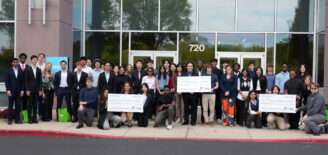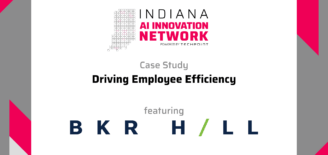Indiana’s Unfair Competitive Advantage at the Tech Frontier
An October 2023 Burning Glass Institute (BGI) report identifying and assessing “Cities on the Tech Frontier,” makes the case that a proper evaluation of regional economic competitiveness cannot rely only on measurements of workforce size and earnings. Instead, evaluations should also focus on the quality of the workforces based on their communities’ concentration of leading-edge digital skills.
A deep dive into the report points to the far-reaching potential of the work we are doing in collaboration with many key partners throughout the state, starting with our audacious goal of making Indiana a global leader for digital innovation by enhancing the state’s connectivity, elevating its industry and expanding its tech talent pipeline. A key part of reaching that goal is our skills-first approach to the workforce, which drives our Mission 41K goal of collaboratively and inclusively growing Indiana’s digital innovation economy by 41,000 workers by 2030.
The BGI report reinforces our belief that our approach will serve as a catalytic convener of the state’s public, private and community sectors. We also believe it gives Indiana an unfair competitive advantage over other regions. And that is great for Hoosiers now, as well as future generations.
We are already exceeding our initial goals. Our Mission 41K update report earlier this year found that in collaboration with many key partners, we grew Indiana’s tech workforce by more than 5.6 percent, double the prior year rate. We added more than 6,305 net new tech jobs, and we increased the percentages of women and people of color in the tech-related workforce.
The BGI report makes a critical designation around the quality and type of skills, highlighting that true competitiveness relates to leading-edge skills vs. regions with a large tech workforce concentration, like Washington, D.C., in legacy technologies used in government and defense. Failing to track these leading-edge skills in the face of rapid technological change and increased use and adoption of artificial intelligence in the broader world of work “will see regions fall farther behind at a faster rate than we’ve seen through previous technological advances,” the report says.
It’s no surprise which cities made the top of the lists in the report: it is again the usual suspects with high concentrations of large tech firms and a high metropolitan statistical area (MSA) population overall: Seattle, San Jose, and San Francisco are in a league of their own, followed by other traditionally tech heavy MSAs that include Boston, Austin, San Diego and New York City.
But a number of Indiana cities and regional territories were cited as being “on the rise,” and it is there that we see validation and promise.
As a wide range of industries are increasingly tech-enabled and data-driven, a growing share of
tech workers are employed outside the tech sector. In 2022, more than a third of software developers worked in industries other than Information and Professional and Technical Services. Here in Indiana, more than 92 percent of our tech talent works outside of the core tech sector and roughly 95 percent are in small and midsize companies.
We know the tech workforce is extremely dynamic, constantly evolving and innovating, with talent and skill concentrations ever shifting across regions. It’s why we are focusing on inclusive growth and skill development for our talent pipeline.
The BGI report captured the growth phenomenon as it relates to skill development for specific regions by creating a separate ranking based on each region’s momentum, as distinct from the current concentration of Frontier Skills – skills that command a high wage premium while also demonstrating rapidly growing demand – in the workforce. The momentum rankings consider a weighted average of the growth of tech employment in the region and changes in the demand for Frontier Skills within new job openings.
These two rankings are critical to understanding the overall health and growth opportunity for a given region relating to the quality of jobs available that are in line with the overall direction the economy is going. Regions where there is not only strong employment growth but also increasing demand for digital skills signals that the region is adding jobs that are currently relevant and likely to stay that way, creating a more resilient workforce.
Indianapolis-Carmel-Anderson ranked 17th overall for medium-sized MSAs’ tech worker momentum in the report and 32nd in their current share of tech workers with Frontier Skills.
Several regions with large tech workforces ranked relatively highly in terms of their existing Frontier Skill supply, but have only middling momentum. The BGI report says that means they risk being overtaken if they don’t work to attract more advanced technology jobs.
“The combination of a region’s current concentration of Frontier Skills and its momentum represents a powerful assessment of the competitiveness of its tech workforce, offering critical insights to industry, higher education, and government on how best to support workforce and economic development efforts and to build the local talent base,” the report says.
The report cites Pittsburgh as a key example of success in intentional efforts being used to expand and grow their tech workforce, with many of their levers mirroring that of Indiana. The Pittsburgh example highlights innovations in software and robotics for advanced manufacturing and autonomous vehicles along with a strong anchor of research and development in Artificial Intelligence (AI) at Carnegie Mellon University.
Here in Indiana, examples of digital innovation include:
- Development of the Indiana Hard Tech Corridor, stretching from Purdue University in West Lafayette to the 16 Tech Innovation District in Indianapolis that will focus on high-speed lab-to-market innovation for advances in areas ranging fromsemiconductors to hypersonics.
- Launch of new research institutes at Indiana University, the Convergent Bioscience and Technology Institute and the Institute for Human Health and Wellbeing. Aligned with the IU 2030 strategic plan, these Indianapolis-based institutes will drive transformative research in health, medicine, life sciences, and technology.
- Notre Dame’s intentional approach through the creation of the IDEA Center, as an innovation engine not only for the university but also for the entire north central Indiana region.
- Recent Federal Technology Hub designations across the state for biotechnology, clean hydrogen, domestic production of microelectronics, semiconductor manufacturing and other advanced technologies, and wireless innovation.
- Two multi-billion electric vehicle battery plants in the Kokomo area are being developed by Stellantis and Samsung SDI.
- Eli Lilly and Company plans two manufacturing sites in the Lebanon area and broke ground this spring as anchor of a new innovation district there.
Additionally, our sister initiative, Conexus Indiana, is helping the advanced manufacturing sector adopt Industry 4.0 technology to retain the state’s position as having the highest concentration of advanced manufacturing jobs in the U.S. through programs aimed at both talent and technology.
Under the State of Indiana’s Manufacturing Readiness Grants program, Indiana companies have invested nearly $813 million in advanced technologies, and employers are upskilling their current workforce to succeed in an Industry 4.0 economy. Research led by Conexus Indiana and Lightcast in September 2023, forecast employment growth of 5 percent to 10 percent in several of Indiana’s priority advanced manufacturing sectors, predicting the transportation equipment, chemical, and computer and electronic product manufacturing subsectors could add over 13,000 jobs to Indiana’s economy by 2026.
Each of the projects bulleted above, and dozens more around the state, are indications of a thriving landscape of innovation across multiple economic sectors, all of which will drive demand for Frontier Skilled workers.
Getting more people and companies better at tech, particularly leading-edge tech, in our advanced sectors, is the biggest growth driver for productivity and overall economy.
This is where TechPoint serves as the unfair competitive advantage for Indiana in that we are focused not only on the adoption of these proven best practices, but also tracking and sharing out progress in these areas. In Indiana, we are collaborating across many fronts to collectively impact our overall economic growth.
Interested in growing your digital skills for Indiana’s in demand tech jobs? Through TechPoint’s partnership with Infosys Foundation USA, Hoosiers can access more than 12,000 digital upskilling courses through the online learning platform, Infosys Springboard USA. Learn more and begin your digital learning journey to a career in tech today here.


